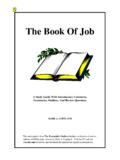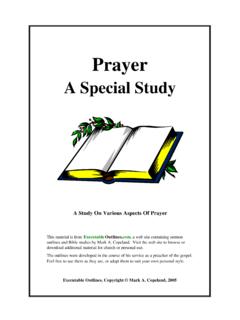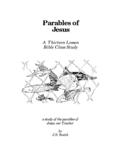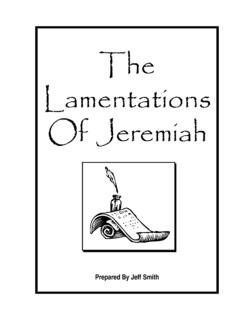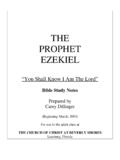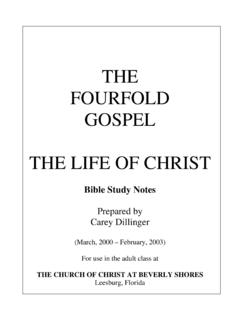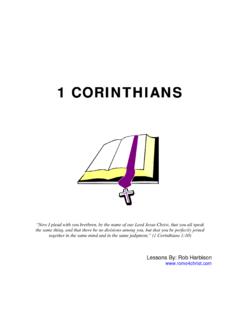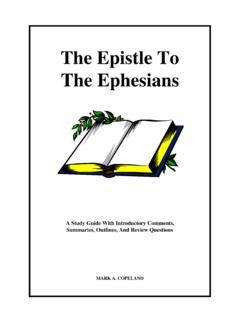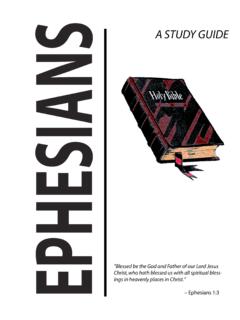Transcription of The Epistle To The Romans - Bible Study Guide
1 The Epistle ToThe RomansA Study Guide With Introductory Comments,Summaries, Outlines, And Review QuestionsMARK A. COPELANDThe Epistle To The RomansTable Of ContentsIntroduction3 Chapter One6 Chapter Two9 Chapter Three12 Chapter Four15 Chapter Five18 Chapter Six21 Chapter Seven24 Chapter Eight27 Chapter Nine30 Chapter Ten33 Chapter Eleven36 Chapter Twelve39 Chapter Thirteen42 Chapter Fourteen44 Chapter Fifteen46 Chapter Sixteen48 This Study Guide was developed in preparation for teaching adult Bible objectives for each section are usually things I plan to emphasize during have found that summarizing and outlining helps me to better understand the Wordof God.
2 It is a practice I highly recommend to generally delete the answers to the review questions before printing the materialand giving it to the students. But that you might know what answers were intendedby the questions, I have included them in these outlines were developed in the course of my ministry as a preacher of the gospel. They areincluded in The Executable Outlines Series, a collection my sermon outlines and Bible studymaterials. Visit the EO web site ( ) to browse or download more material. Feel free to usethem as they are, or adapt them to suit your own personal style. To God be the glory!The Executable Outlines Series, Copyright Mark A.
3 Copeland, A. CopelandThe Book Of Romans 2 The Epistle To The RomansIntroductionAUTHORPaul, the apostle (1:1). The authorship of this Epistle has been universally accepted, even by hereticalsects who did not like Paul. It is ascribed to Paul by Clement of Rome, Polycarp, Irenaeus, Tertullian, and many other writers in the early church. The internal evidence is also supportive of Paul as its OF WRITINGC orinth, as evident from the greetings of Gaius, who lived at Corinth (16:23; 1 Co 1:14), and ofErastus, who had settled down there (16:23; 2 Ti 4:20). Also, Phoebe, who apparently accompaniedthe Epistle (16:1-2), was from the church at Cenchrea, a "suburb" of OF WRITING57-58 ; while on his third journey (Ac 20:1-3), just prior to his arrival to Jerusalem with thecollection for the needy saints (15:25-26; Ac 20:16; 24:17).
4 BACKGROUND OF THE CHURCH AT ROMEN othing is revealed in the New Testament as to the start of the church in Rome. It is possible thatvisitors to Jerusalem on the day of Pentecost following the Lord's ascension were among the 3000saved and later took the gospel with them back home (Ac 2:10). Or it could be that among thosedispersed following Stephen's death were some that went to Rome and preached the gospel there (Ac8:1-4).The first we read of Christians from Rome is possibly that of Aquila and Priscilla, who along with allJews were expelled from Rome by Claudius and were found by Paul at Corinth during his secondjourney (Ac 18:1-2). After travelling with Paul to Ephesus and working with the church there (Ac18:18-19, 24-26; 1 Co 16:19), we find them back at Rome and hosting a church in their house(16:3-5).
5 From the greetings given by Paul in chapter sixteen, it appears that there were several churches in Romemeeting in various homes (16:5,14,15). The names of individuals would suggest that the Christianswere primarily Gentiles, with a smaller number of reputation of the Christians in Rome was widespread; both their faith (1:8) and obedience (16:19)were well known. For this reason Paul had long wanted to see them (15:23), with the goal of sharing intheir mutual edification (1:11-12) and to be assisted on his way to Spain (15:22-24).Mark A. CopelandThe Book Of Romans 3 PURPOSE OF WRITINGPaul expresses in this Epistle that he had for some time planned to preach the gospel at Rome (1:13-15)and from there go on to Spain (15:22-24).
6 Though he still had these intentions (15:28-29), thespreading cancer of the "Judaizing teachers" which had disrupted churches in Antioch, Corinth andGalatia was likely to make its way to Rome. To prevent this, and to assure that his visit to Rome wouldbe a pleasant one (15:30-33), Paul writes:TO SET STRAIGHT THE DESIGN AND NATURE OF THE GOSPELIn doing so, he demonstrates how the gospel of Christ fulfills what is lacking in both heathenism andJudaism, thereby effectively replacing them as religious systems. Such an Epistle would arm the churchat Rome against those who would pervert the gospel or suggest that it was inadequate by : Romans 1:16-17"For I am not ashamed of the gospel of Christ, for it is the power of God tosalvation for everyone who believes, for the Jew first and also for the in it the righteousness of God is revealed from faith to faith; as it iswritten, 'The just shall live by faith.
7 '"In these two verses Paul states his confidence in the gospel and the reasons for it. The bulk of hisepistle is devoted to explaining why and how the gospel of Christ is God's power to save those OUTLINE (adapted from Dextor Sammons)INTRODUCTION (1:1-17) BY FAITH (1:18-11:36) - THE "NEED" FOR need of the Gentiles (1:18-2:16) need of the Jews (2:17-3:8) universal need for salvation (3:9-20) BY FAITH - THE "PROVISION" MADE FOR 's righteousness through faith (3:21-31) as an example (4:1-25) - THE "RESULT" OF from wrath (5:1-21) from sin (6:1-23) from the Law (7:1-25) from death (8:1-39)Mark A. CopelandThe Book Of Romans AND GENTILE - THE "SCOPE" OF chooses to save believers (9:1-33) chose to trust in their own righteousness (10:1-21) Jew and Gentile can have salvation through faith (11:1-36) TRANSFORMED LIFE (12:1-15:13) RELATION TO OVERALL CONDUCT (12:1-21) RELATION TO CIVIL AUTHORITY (13:1-7) RELATION TO FELLOW MAN (13:8-14) RELATION TO WEAK BRETHREN (14:1-15:13)CONCLUDING REMARKS, INSTRUCTIONS, AND BENEDICTION (15:14-16:27)REVIEW QUESTIONS FOR INTRODUCTION1)Who wrote the Epistle to the Romans ?
8 - The apostle Paul (1:1)2)From where was it written?- Corinth3)What is the approximate date of writing?- 57 or 58 )What is the purpose of this Epistle ?- To set straight the design and nature of the gospel5)Where is the theme of this Epistle stated?- Romans 1:16-17 Mark A. CopelandThe Book Of Romans 5 The Epistle To The RomansChapter OneOBJECTIVES IN STUDYING THIS CHAPTER1)To be impressed with the all-sufficiency of the gospel2)To see how God's wrath may be directed toward our society todaySUMMARYAs is the custom in most of his epistles, Paul begins by extending greetings and offering himself as a bond-servant of Christ, he mentions his apostleship and its mission in the gospelof God concerning His Son: to bring about the obedience of faith among all the Gentiles (1-6).
9 Addressing the recipients of his Epistle as "all who are beloved in Rome, called as saints," he extends tothem the popular two-fold greeting of that day: "grace" and "peace" (7). He is thankful for theirwell-known faith and reveals his desire to visit Rome and to proclaim the gospel there (8-13). Themotivation behind that desire is his sense of obligation and bold conviction that the gospel is God'spower to save (14-17).The mention of "salvation" naturally leads to the need for all men to be saved. Paul begins todemonstrate this need on the part of the Gentiles. He explains that because of the Gentiles' failure toacknowledge the eternal power and divine nature of God as revealed in the world around them, and fortheir subsequent pride and idolatry, they were therefore exposed to God's wrath from heaven (18-23).
10 This wrath manifested itself in God simply letting them reap the fruits of their vanity. By giving them over"to uncleanness, in the lusts of their hearts," "to vile passions," and "to a debased mind," the result wassuch corruption that even those who knew better were caught in its clutches (24-32).OUTLINE (adapted from Jim McGuiggan) & THEME (1-17) PAUL (1-5) place in life: servant & apostle (1) story in life: the gospel of Christ (2-4) purpose in life: to produce obedience based on faith (5) THE Romans (6-15) 's description of them (6-7) 's report of them (8) 's deep desire to visit them (9-10) 's reason and eagerness to visit them (11-15)Mark A.
